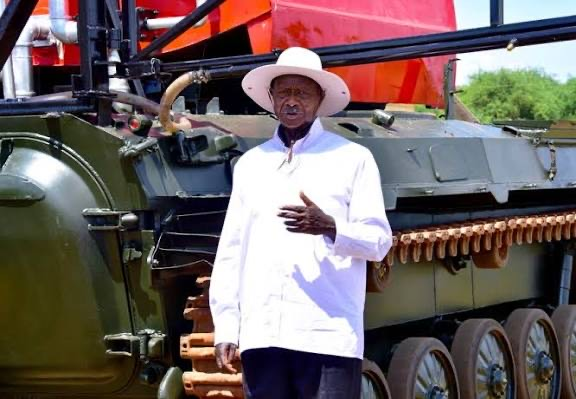By: Boy Fidel Leon
President Yoweri Museveni has unveiled what could become one of Uganda’s most ambitious innovations. A prototype all-terrain firefighting vehicle he has christened the “Muliro/Moto Eater.”
The vehicle, resembling an armoured tank, is no ordinary fire truck. It’s designed to crawl over hills, ditches, and rugged landscapes that conventional engines cannot reach. It represents Museveni’s attempt to address not only Uganda’s wildfire risks but a global crisis. He says the world is failing to fight effectively.
“As a man of war, I used to fight fires myself. We would put them out using leafy branches and approach the fire from the back,” the President recalled. Drawing from his bush-war years.
Now, decades later, that combat instinct has been redirected to the fight against wildfires. Museveni explained that the concept came to him after observing devastating blazes on television. Flames consuming towns in the United States, sweeping through Greece, Australia, and Canada.
“Planes release only small amounts of water,” he argued. “It is not enough to control large-scale incidents. What is needed is land-based capacity.”
The “Muliro/Moto Eater” is not just another government project handed off to consultants. Museveni insists the design grew directly out of his own military thinking and indigenous knowledge.
“As a fighter, I have acquired a lot of knowledge,” he said. “So I combined my indigenous knowledge and fighting skills to design an armoured prototype firefighting vehicle.”
He pitched the idea to Marcé Industries, a South African firefighting equipment manufacturer, in 2023. The company, together with Specialised Concept, took on the challenge and began building a prototype at their own cost. By December 2024, Museveni’s delegation had inspected the first model, which now includes a locust spray prevention system as an additional feature.
The prototype is built for extremes. It runs on rubber tracks that allow it to scale steep hills, cross ditches, and move at speeds of up to 60 km/h. Its tank-like build ensures mobility on both rugged terrain and normal roads. This makes it a rare firefighting vehicle that could operate deep in Uganda’s countryside. It can also be useful anywhere in the world facing wildfires.
The National Enterprise Corporation (NEC) and Uganda’s Ministry of Transport have inspected and verified the vehicle’s capability.
For Museveni, the “Muliro/Moto Eater” is about more than firefighting. It is a statement that Uganda can innovate, build, and even contribute solutions to crises that richer nations still struggle with.
The unveiling was not a closed domestic affair. Amongst the guests were diplomats from the United States, the European Union, and Russia. These are three blocks that also confront wildfire disasters. Museveni reminded them that his idea was first shared with former U.S. Ambassador Deborah Malac years ago.
“I realised I needed to help these people,” he said, positioning his innovation not just as a national asset but a philanthropic gesture to the world.
The presence of international envoys suggested a calculated message. Uganda is not only solving its own problems but also offering its ingenuity to the global stage.
The prototype, however, raises questions. Will the “Muliro/Moto Eater” move beyond a single showpiece into mass production? Can Uganda shoulder the costs of manufacturing such complex machines locally, or will it remain dependent on South African partners?
For now, the government has not announced a production plan or procurement timeline. What was presented at State House was one machine, one idea, and one man’s vision.
Still, in a country where bushfires remain a recurring threat, from national parks to farmland, the potential is undeniable. If scaled, the “Muliro/Moto Eater” could redefine firefighting across Africa.
In Museveni’s telling, the prototype is not only a tool but a metaphor. Fires, whether literal or symbolic, require preparation, courage, and innovation to fight. Uganda’s journey with this vehicle is just beginning.
As the proverb goes, “Stealing a drum is easy; finding a place to beat it is not.” The unveiling was the easy part. The harder task lies ahead: turning a prototype into a reliable fleet, proving it works beyond demonstrations, and ensuring that when the fire comes, Uganda will be ready.


